Diamond Grading System
About SNJ Grading System (SGS)
We educate our customers about our minute grading system on various factors. Due to this we can take full advantage to promote & increase our business through E-Commerce. We manufacture 0.30 cts to 10 cts sizes in Round, Princess, Marquise, Pear, Oval, Square Emerald, Emerald, Square Radiant, Radiant, Heart, Cushion etc. Grading is carried out according to rigorous criteria mapping with Labs of International repute & various other minute factors developed by our well Equipped Research Laboratory Team. In our laboratory we have taken care of each C's in depth so that you can visualize the stone in front of your eyes. Our grading is based on GIA system so there is higher chance of upward color certification in other Lab. To narrow down the price band we give (+) color & (+/-) clarity grading.
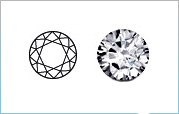
Round – (RD)
This is by far the most popular of the shapes available today. Using precise mathematics and theories on the interplay of light, the process of producing a Round Diamond has been fine tuned for over a century to bring forth this shape's magnificent fire and brilliance.
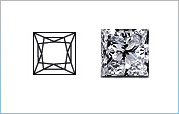
Princess – (PR)
Just like the aura that surrounds its name, a Princess Diamond is a thing of beauty. Cut in a traditional square with pointed corners, a Princess Diamond exudes elegant brilliance and is often used to adorn an engagement ring.
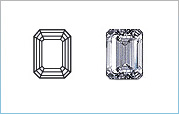
Emerald – (EM)
The Emerald Diamond draws inspiration from the traditional pavilion cut of emerald gemstones. In the Emerald Diamond, the pavilion is cut with rectangular facets to produce a unique optical appearance, offering a larger, open table that highlights the clarity of the diamond.
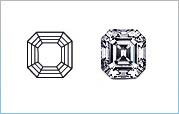
Asscher (Square Emerald) – (SQEM)
Similar to the emerald-cut is the Asscher. Only it is square in shape. While keeping to the overall emerald-cut, the pavilion is faceted to produce a unique refractive appearance.
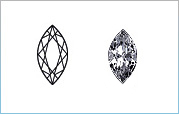
Marquise – (MQ)
The Marquise brings to mind the sophistication and elegance of the French. Born of nobility, this shape is perfect for long slender fingers and gives the illusion of largeness in comparison to other diamonds. A Marquise Diamond often looks stunning when it is set with Round or Pear-shaped side stones.
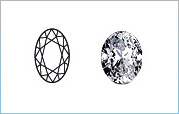
Oval – (OV)
Oval Diamonds are highly regarded for their inner brilliance and eye-catching shape. Especially when languidly flashed from slender fingers.
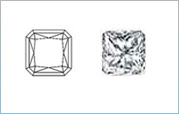
Square Radiant – (SQRT)
While all Radiant Diamonds do not have precisely the same shape, the Square Radiant Diamond is distinctly square in its silhouette. One of the most preferred types in jewelry, it’s even shape and signature trimmed corners work well when set with side-highlight diamonds such as Baguettes or Round Diamonds.

Radiant - (RT)
At first glance you may be surprised. Here is a diamond shape that somehow had its corners trimmed off! But this is precisely the signature of a Radiant. A popular and versatile choice for jewelry, the radiant-cut looks equally beautiful set with either baguette or round side-diamonds. Radiant-cut diamonds can vary in their degree of being rectangular.
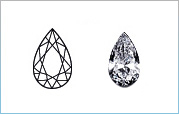
Pear – (PS)
As sparkling as a falling tear. As softly rounded as a Pear fruit. This is the sweet and elegant Pear Diamond shape. This shape is often chosen for its romantic appeal as well as its flaring design. An elongated Pear Diamond shape creates a subtle slimming effect on fingers.
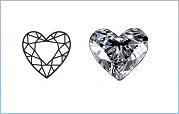
Heart – (HRT)
The symbol of love. This is a choice for the romantic. A Heart Shape speaks of love like no other. A distinct and purpose-derived shape, the Heart Shape is often the lover's preferred diamond gifting choice.
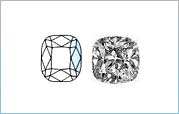
Cushion Brilliant(CUBR), Cushion (CU), Cushion Modified Brilliant (CUMBR)
Also known as a 'Pillow-cut', Cushion Shape diamonds have rounded corners and larger facets that increase their brilliance. Cushion Shape diamonds are available in a variety of shapes including square and rectangular.

Triangle (TA), Trilliant (TR)
A shape that fits all occasion and reason. This shape is often chosen for its romantic appeal as well as its flaring design. A popular and versatile choice for jewelry. TA contains 22 facets while TR contains 43 facets.
Carat
The unit of measurement used to describe the weight of diamonds is called 'Carat'. The 'Carat' weight is commonly expressed in points or fractions.
1 carat is equal to 0.2 grams, or 0.007 ounces.
5 carats is equal to 1 gram.
141.7 carats is equal to 1 ounce.
There are 100 points in 1 carat. For instance, 0.33 carats is generally expressed as 33 points, or 1/3 of a carat.
Carat means weight of diamond which reflects its size. One carat diamond weighs 100 cents. (1 ct = 100 cents ) Diamond sizes can be expressed by its weight (unit), pointers or stones per carat.
| Price consideration with Size Range. | Weight (unit): 1ct=100 cents 5cts = 1.000gms |
|---|---|
| 0.15 | 0.15 - 0.17 |
| 0.18 | 0.18 - 0.22 |
| 0.23 | 0.23 - 0.29 |
| 0.30 | 0.30 - 0.39 |
| 0.40 | 0.40 - 0.44 |
| 0.46 | 0.45 - 0.49 |
| 0.50 | 0.50 - 0.59 |
| 0.60 | 0.60 - 0.69 |
| 0.70 | 0.70 - 0.74 |
| 0.75 | 0.75 - 0.79 |
| 0.80 | 0.80 - 0.89 |
| 0.90 | 0.90 - 0.99 |
| 1.00 | 1.00 - 1.19 |
| 1.20 | 1.20 – 1.49 |
| 1.50 | 1.50 – 1.69 |
| 1.70 | 1.70 – 1.99 |
| 2.00 | 2.00 – 2.99 |
| 3.00 | 3.00 – 3.99 |
| 4.00+ | 4.00 - 100.00 |
Color Scale
Diamonds act as prisms, dividing light into a spectrum of colors and reflecting this light as colorful flashes referred to as a diamond's 'fire'. The more colorless a diamond is, the more vividly colorful the 'fire' will appear.
Diamonds come in every color of the spectrum, but the most popular gems are colorless. Truly colorless, icy-white diamonds are extremely rare, and therefore, most costly. Stones are graded by color and given designations dependent on how far they deviate from the purist white.
The best way to see the true color of a diamond is by looking at it against a white surface. Although the majority of diamonds come in shades of white, the gems also come in a spectrum of majestic colors, from red and canary yellow to blue, green and brown. These colorful diamonds, known as fancies, are valued for their depth of color, just as white diamonds are valued for their lack of color.
Grades in the color of diamonds range from D - Z. D is being truly colorless and of the highest quality. E and F are also graded as colorless while G, H, I and J are near colorless. Diamonds graded K, L and M will have obvious hints of color and as the scale approaches P, you may find subtle changes in hue and tone. The exceptions to the rule are 'Fancy' diamonds in well-highlighted colors that include pink, blue, red, green and canary yellow. These are particularly rare and highly treasured.
Clarity Grade
A diamond's clarity refers to the presence of identifying characteristics on and within the stone. While most of these characteristics are inherent qualities of the rough diamond, and have been present since the earliest stages of the crystal's growth below ground, a few are actually a result of the harsh stress that a diamond undergoes during the cutting process itself.

FL Flawless
Diamonds in this range have no inclusions, neither internal nor external.

IF Internally Flawless
No internal inclusions visible with 10x magnification. There may be some tiny external irregularities in the finish.

VVS1 Very very slightly included 1
Extremely difficult to see the inclusion. Even difficult to spot by trained eyes with 10 x.

VVS2 Very very slightly included 2
Still difficult to see the inclusions with 10x magnification but easier than VVS1.

VS1 Very slightly included 1
Little difficult to see the inclusions with 10x magnification.

VS2 Very slightly included 2
Very small inclusions visible with 10x magnification

SI1 Slightly included 1
Small inclusion visible with 10x magnification.

SI2 Slightly included 2
Small inclusions easily visible with 10x magnification.

I1 Included 1
Inclusions that may be easily visible to the naked eye for a trained observer.

I2 Included 2
Many flaws clearly visible to the naked eye that also decrease the brilliance
CUT (PROP)
Diamond's beauty depends upon optical properties such as high Refractive index, color dispersion, luster & high degree of clarity. We give strong thrust on cut grading. Due to well equipped manufacturing system our stones are best polished. Luster means fire of diamonds. Better the Polish, brighter & more lustrous the stone. At the time of cutting take care that the light entering from top should not be lost through the teak pavilion sides. So Customer gets to observe almost 100% light from a round brilliant cut diamond. i.e. (82-83% from total internal reflection & 17 -18 % from luster). This phenomenon is known as "LIFE". As diamond critical angle is 24*, brilliance of diamond depends upon pavilion facets & pavilion angle. Cut determines brilliance. In RBC diamond Crown facets act like small prism, which split white light. Small crown gives less Dispersion & more Brilliance vice versa.
Lay people often confuse a diamond's SHAPE with its CUT; this is most likely due to the industry's synonymous use of the terms "cut" and "shape" to describe a diamonds shape (outline), i.e. marquise cut, round brilliant cut, or pear shape. In reality when we refer to the "cut" or "make" of a diamond, we are really referring to a compilation of three factors. It’s PROPORTIONS in terms of degrees and percentages... the quality of its POLISH or finish... and the SYMMETRY of its facets... These three factors result in the "Overall Cut Grade" of the diamond.

(ID) IDEAL
Ideal cut diamonds are round diamonds that have been cut to exact, mathematical proportions. It must be symmetrical, and have 58 facets, placed exactly according to formula. These diamonds are cut to maximize the brilliance and sparkle of the stone.

(EX) EXCELLENT
This cut is intended to maximize brilliance and is as near to ideal proportions as possible. The typically smaller table sizes of these diamonds have the added benefit of creating a great deal of dispersion - or 'fire' - as well.

(VG) VERY GOOD
This cut deviate slightly from the Excellent cut proportions in order to create a larger diamond. However, diamonds in this category reflect the majority of the light that enters them, creating a good deal of brilliance

(GD) GOOD
Diamond in this category will reflect much of the light that enters them. Their proportion falls outside of the preferred range because the cutter has chosen to create the largest possible diamond. Good cut diamonds offer an excellent cost-saving without sacrificing quality or beauty.

(FR) FAIR
A diamond graded as Fair will be cut to a lower standard that reflects only a small proportion of the light that enters it as compared to Good cut diamonds, losing fire and brilliance.
POLISH - PO
Polish can be result of the finishing process or be affected by blemishes created after cutting. The term "Polish" refers to the degree of "polishing lines" that appear on the surface of a finished diamond which can be seen with the use of 10x magnification. These polishing lines are caused by the minute diamond crystals which are embedded in the polishing wheels used by the diamond cutters to polish the surface of the diamond after cutting. While not quite the same in appearance, they are similar in concept to the swirl marks left on the surface of a car from the use of an orbital buffer, but are much less noticeable. It is important to note, however, that polish lines are straight in appearance.
| Code | Description |
|---|---|
| (ID) IDEAL | This is our predilection. No polish lines or marks are visible when the diamond is viewed under 10x magnification. High magnification, such as 30x may be used to locate any possible imperfections. The brilliance of a diamond with Ideal Polish will be noticeably superior to that of a diamond with a polish rating of Excellent. |
| (EX) EXCELLENT | This is our preference. No polish lines or marks are visible when the diamond is viewed under 10x magnification. High magnification, such as 30x may be used to locate any possible imperfections. The brilliance of a diamond with Excellent Polish will be noticeably superior to that of a diamond with a polish rating of Very Good. |
| (VG) VERY GOOD | Represents diamonds that contain one or two minor groupings of transparent polish lines that are visible under 10x magnification. Higher magnification will again be used to locate these areas easily. The degree of brilliance between a diamond graded as Very Good in Polish and Good is still noticeably different |
| (GD) GOOD | Numerous areas consisting of minor transparent lines are visible under 10x magnification. Occasional white polish lines may also be visible, but limited in number. As a bare minimum, we recommend that a diamond have a Polish Grade of Good or better. However, it is important to note that it is difficult to have Excellent or Very good polish in most of fancy shape diamonds so generally it carries Good polish. |
SYMMETRY - SY
Symmetry refers to the precision with which the facets of a diamond are aligned with each other and the consistency of facet shape and size per given section. The symmetry rating reflected on a diamond grading report is not an indication of the proportions of a diamond.
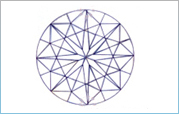
(ID) IDEAL
No misshapen or miss-aligned facets are visible when the diamond is viewed under 10x magnification. High magnification, such as 30x may be used to locate any mis-aligned or misshapen facets. The brilliance of a diamond with Ideal Symmetry will be noticeably superior to that of a diamond with a symmetry rating of Excellent.
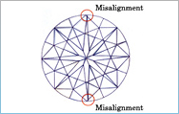
(EX) EXCELLENT
No misshapen or mis-aligned facets are visible when the diamond is viewed under 10x magnification. High magnification, such as 30x may be used to locate any mis-aligned or misshapen facets. The brilliance of a diamond with Excellent Symmetry will be noticeably superior to that of a diamond with a symmetry rating of Very Good.

(VG) VERY GOOD
Represents diamonds that contain one or two minor symmetry characteristics that can be found under 10x magnifications. Higher magnification will again be used by the grader to locate these areas easily. The degree of brilliance between a diamond graded as Very Good in Symmetry and one graded as having Good Symmetry is still noticeably different, however, it is practically impossible for the average consumer to distinguish between Very Good and Excellent or Ideal Symmetry without a lot of coaching.
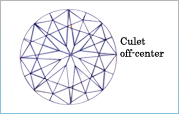
(GD) GOOD
Numerous inconsistencies of facet alignment and shape are visible under 10 x magnifications. As a bare minimum, we recommend that a round brilliant cut diamond have a symmetry rating of Very Good or better. However, it is important to note that it is difficult to have Excellent or Very good symmetry in most of fancy shape diamonds so generally it carries Good symmetry.
HEARTS & ARROWS (HA)
Faceted diamond forms a well aligned, symmetrical & balanced form that reveals the well known eight rayed arrow pattern which you can see through special device like the Fire scope by keeping diamond face up. Here symmetry pattern can be seen in perfect order. Perfect Heart shape will be observed from the pavilion side. Maximum Life, Fire, & Sparkle are observed in diamonds that has been cut, faceted in certain specific proportions. These parameters are followed by our skilled artisans.

EX – EXCELLENT
This diamond has all its hearts and arrows in perfect shape and with accurate dimensions. It displays Very high brilliance.

VG – VERY GOOD
This diamond has most of its hearts and arrows in perfect shape and with accurate dimensions. It displays Very high brilliance but less than EXCELLENT Heart & Arrows

GD - GOOD
These diamonds will have a good number of its hearts and arrows in perfect shape and with accurate dimensions.It display Very high brilliance but less than VERY GOOD HEARTS & ARROWS.
FLUORESCENCE – FL
When we speak of Diamond Fluorescence, we are referring to the diamonds tendency to emit a soft colored glow when subjected to ultraviolet light (such as a "black light"). Fluorescence is a form of illumination that is created when a diamond is exposed to low or high wave ultraviolet radiation. Faint or medium fluorescence will rarely affect a diamond's appearance. Usually fluorescence is unnoticed by the human eye in ordinary light. Fluorescence can cause a diamond to appear less clear or slightly hazy if the diamond exhibits very strong or extreme fluorescence. When selecting your diamond it is best to choose a diamond that has no fluorescence or faint to moderate fluorescence.
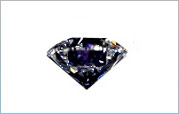
N – NONE
This diamond do not have any fluorescence
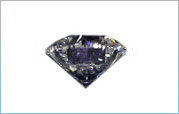
F – FAINT / VERY SLIGHT
This diamond have weak fluorescence, not a significant influence on color
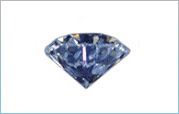
M – MEDIUM / SLIGHT
This diamond have average fluorescence, small influence
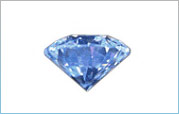
S– STRONG
This diamond have strong influence, substantial color influence
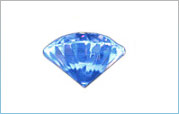
VS – VERY STRONG
This diamond have very strong influence, substantial color influence
LUSTER - LU
This is another parameter, which has been found of importance in determining the exact purity of the diamond. The amount of light that the stone reflects and the type of light that is emitted by the stone determine luster of a diamond. Luster refers to the quality of a surface in reflected light. The luster of a diamond is usually described as adamantine luster.
| Code | Description |
|---|---|
| (EX) EXCELLENT | This diamond has very high quality reflection and emission of light. |
| (VG) VERY GOOD | This is our preference. No polish lines or marks are visible when the diamond is viewed under 10x magnification. High magnification, such as 30x may be used to locate any possible imperfections. The brilliance of a diamond with Excellent Polish will be noticeably superior to that of a diamond with a polish rating of Very Good. |
| M1 - LIGHT MILKY | This diamond has high quality reflection and emission of light. |
| M2 – MEDIUM MILKY | This diamond has low quality reflection and emission of light. |
| M3 – HEAVY MILKY | This diamond has very low quality reflection and emission of light. |
GIRDLE
The outer edge of a diamond which forms a band around the stone. The girdle can be faceted or non-faceted
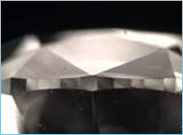
(F) FACETED
A faceted girdle consists of a small series of polished facets. Diamond cut in a way to include many facets. The multiple facets structure increases light reflection and gives the stone a bright and shining look.
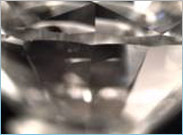
(NF ) NON-FACETED
Diamonds that do not have geometrically shaped flat polished facets are graded as non faceted
CULET
A diamond's culet is the point on the bottom of a diamond's pavilion. A diamond's culet may be pointed or it may be blunted with a small facet. The culet facet can vary in size. This culet's size determines the grade that the culet is assigned.
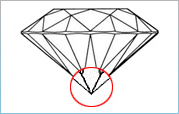
PO - POINTED
If there culet faceted is NONE then it is referred pointed culet. The kite facets of the crown should exactly intersect with the pointed edge of the pavilion main facet and the upper girdle facet should synchronize with girdle facets. There should be a perfect alignment and no sideways displacement with respect to each other
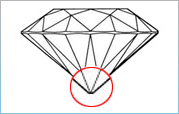
MD - MEDIUM
If culet faceted is medium then it is referred as medium culet
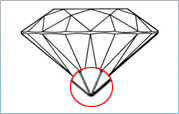
FC - FACETED
If culet faceted is very high then it is referred as faceted culet. This culet should lie in the centre of the octagonal table. It is very easy to see whether the culet is eccentric from a side view of the stone as well as on looking through the table.
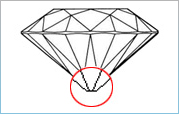
BR - BROKEN
If culet facet is broken then it is referred as broken culet
EXTRA FACETS - EF
Occasionally a cutter will find the need to remove an inclusion near the surface or to compensate for facets which do not meet correctly and he will add an "extra facet". Extra facets have no effect on clarity grades. This is subdivided in Two parts: - 1) EFCR: - Extra Facets on Crown, 2) EFPV: - Extra Facets on Pavilion.

NV - NOT VISIBLE
Very difficult to find the extra facet on crown. It is not visible on crown.

MN – MINOR
Difficult to find extra facet on crown. It is slightly visible on crown with 10x magnification

MD – MEDIUM
Easy to find extra facet on crown. It is visible on crown with 10x magnification.

MJ – MAJOR
Very easy to find extra facet on crown. It is easily visible on crown with 10x magnificationt
Extra Facets on Pavilion (EFPV)

 About SNJ
About SNJ